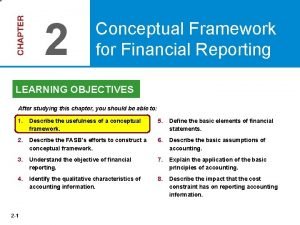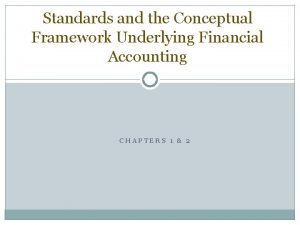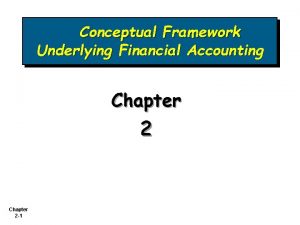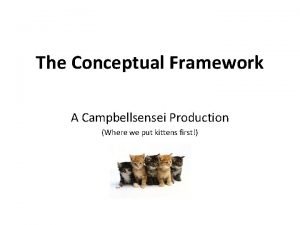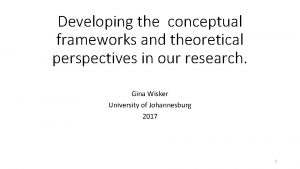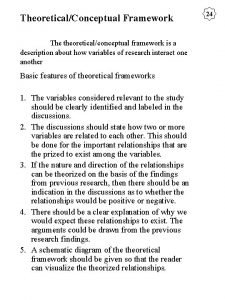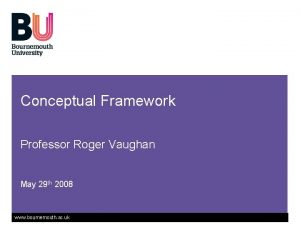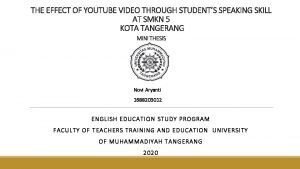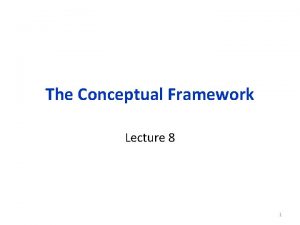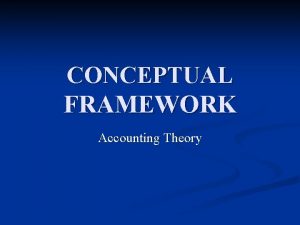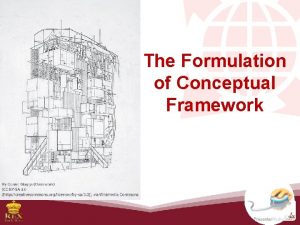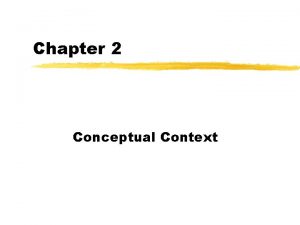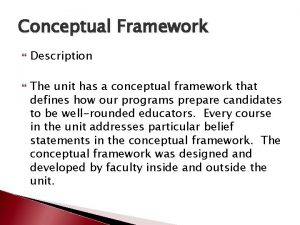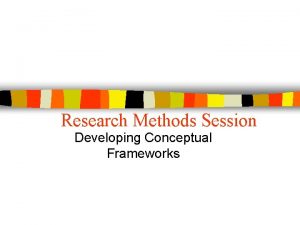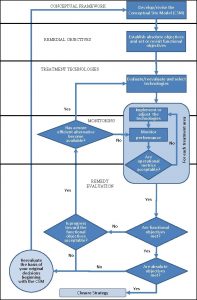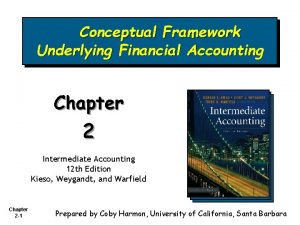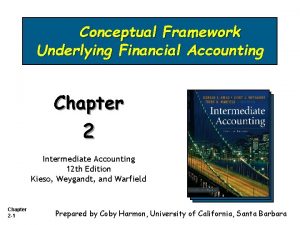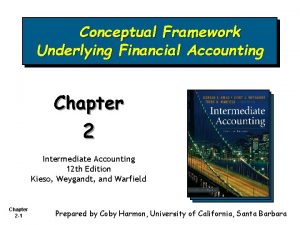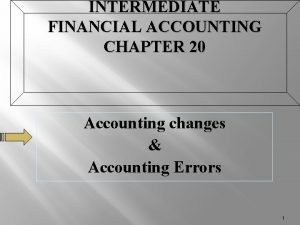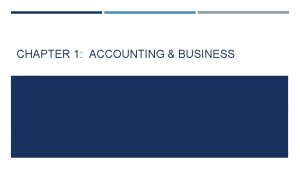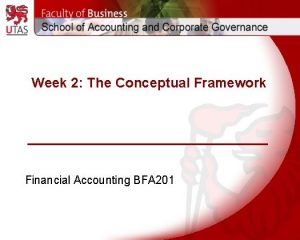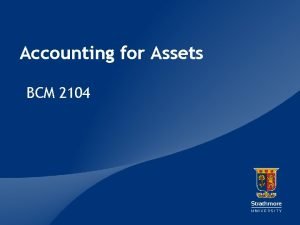CHAPTER 12 CONCEPTUAL FRAMEWORK OF ACCOUNTING l l



























- Slides: 27

CHAPTER 12

CONCEPTUAL FRAMEWORK OF ACCOUNTING l l l Generally accepted accounting principles are a set of rules and practices that are recognized as a general guide for financial reporting purposes. Generally accepted means that these principles must have substantial authoritative support. The Canadian Institute of Chartered Accountants (CICA) is responsible for developing accounting principles in Canada.

CICA’S CONCEPTUAL FRAMEWORK l The conceptual framework consists of: – objective of financial reporting, – qualitative characteristics of accounting information, – elements of financial statements, and – recognition and measurement criteria (assumptions, principles, and constraints).

OBJECTIVE OF FINANCIAL REPORTING l The objective of financial reporting is to provide information that is useful for decision-making

QUALITATIVE CHARACTERISTICS OF ACCOUNTING INFORMATION l l The accounting alternative selected should be one that generates the most useful financial information for decision making. To be useful, information should possess the following qualitative characteristics: 1. understandability 2. relevance 3. reliability 4. comparability and consistency

UNDERSTANDABILITY l l Information must be understandable by its users. Users are assumed to have a reasonable comprehension of, and ability to study, the accounting, business, and economic concepts needed to understand the information.

RELEVANCE l l l Accounting information is relevant if it makes a difference in a decision. Relevant information helps users forecast future events (predictive value), or it confirms or corrects prior expectations (feedback value). Information must be available to decision makers before it loses its capacity to influence their decisions (timeliness).

RELIABILITY l l l Reliability of information means that the information is free of error and bias – it can be depended on. To be reliable, accounting information must be verifiable – there must be proof that it is free of error and bias. The information must be a faithful representation of what it purports to be – it must be factual.

COMPARABILITY AND CONSISTENCY l l Comparability means that the information should be comparable with accounting information about other enterprises. Consistency means that the same accounting principles and methods should be used from year to year within a company. 2000 2001 2003

RECOGNITION AND MEASUREMENT CRITERIA l l Recognition and measurement criteria used by accountants to solve practical problems include assumptions, principles, and constraints. Assumptions provide a foundation for the accounting process. Principles indicate how economic events should be reported in the accounting process. Constraints permit a company to modify generally accepted accounting principles without reducing the usefulness of the reported information. Assumptions Going concern Monetary unit Economic entity Time period Principles Revenue recognition Matching Full disclosure Cost Constraints Cost - benefit Materiality

GOING CONCERN ASSUMPTION The going concern assumption assumes that the enterprise will continue to operate in the foreseeable future. Implications: capital assets are recorded at cost instead of liquidation value, amortization is used, items are labeled as current or non-current.

MONETARY UNIT ASSUMPTION The monetary unit assumption states that only transaction data capable of being expressed in terms of money should be included in the accounting records of the economic entity. l Also assumes unit of measure ($) remains sufficiently stable over time. Ignores inflationary and deflationary effects. l Should not be included in accounting records Should be included in accounting records Customer satisfaction Percentage of international employees Salaries paid

ECONOMIC ENTITY ASSUMPTION The economic entity assumption states that economic events can be identified with a particular unit of accountability. Example: Harvey’s activities can be distinguished from those of other food services such as Swiss Chalet.

TIME PERIOD ASSUMPTION The time period assumption states that the economic life of a business can be divided into artificial time periods. Example: months, quarters, and years 2000 QTR 1 QTR 2 QTR 3 QTR 4 2001 JAN MAY SEPT DEC 2003 FEB MAR APR JUN JUL AUG OCT NOV

REVENUE RECOGNITION PRINCIPLE l The revenue recognition principle says that revenue should be recognized in the accounting period in which it is earned. – – Production/sales essentially complete Revenues measurable Collection reasonably assured Expenses determinable

REVENUE RECOGNITION l Revenue can be recognized: 1. 2. 3. 4. At point of sale During production At completion of production Upon collection of cash

REVENUE RECOGNTION F. O. B. (WITH TERMS OF SALE) Destination Shipping Point Seller Ownership passes to the buyer at the… Public Carrier Co. Buyer F. O. B. …so revenue is recognized as soon as the goods leave your business. Ownership does not pass to the buyer until the… …so revenue is not recognized until the goods are delivered. Public Carrier Co. Buyer

PERCENTAGE-OF-COMPLETION METHOD OF REVENUE RECOGNITION The percentage-of-completion method recognizes revenue and income on the basis of reasonable estimates of the project’s progress toward completion. l A project’s progress toward completion is measured by comparing the costs incurred in a year to total estimated costs of the entire project. l

ILLUSTRATION 12 -4 FORMULA TO RECOGNIZE REVENUE IN THE PERCENTAGE-OF-COMPLETION METHOD Cost Incurred (Current Period) Percent Complete (Current Period) ÷ Total Estimated Cost Total Revenue = Percent Complete (Current Period) = Revenue Recognized (Current Period) The costs incurred in the current period are then subtracted from the revenue recognized during the current period to arrive at the gross profit.

INSTALMENT METHOD OF REVENUE RECOGNITION l l l The cash basis is generally used only when it is difficult to determine the revenue amount at the time of a credit sale because collection is so uncertain. The instalment method, which uses the cash basis, is a popular approach to revenue recognition. Under the instalment method gross profit is recognized in the period in which the cash is collected.

ILLUSTRATION 12 -8 GROSS PROFIT FORMULAINSTALMENT METHOD Under the instalment method, each cash collection from a customer consists of 1. a partial recovery of the cost of goods sold, and 2. a partial gross profit from the sale. l The formula to recognize gross profit is shown below. l Gross Profit Sales Revenue Gross Profit Margin Cash Collections from Customer = = Gross Profit Margin Gross Profit Recognized during the period

MATCHING PRINCIPLE l l Expense recognition is traditionally tied to revenue recognition. This practice – referred to as the matching principle – dictates that expenses be matched with revenues in the period in which efforts are expended to generate revenues.

MATCHING PRINCIPLE l l Expired costs are costs that will generate revenues only in the current period and are therefore reported as operating expenses on the income statement. Unexpired costs are costs that will generate revenues in future accounting periods and are recognized as assets.

MATCHING PRINCIPLE Unexpired costs become expenses through: 1. Cost of goods sold – Costs carried as merchandise inventory are expensed as cost of goods sold in the period when the sale occurs – so there is a direct matching of expenses with revenues. 2. Operating expenses – Unexpired costs become operating expenses through use

FULL DISCLOSURE PRINCIPLE l l l The full disclosure principle requires that circumstances and events that make a difference to financial statement users be disclosed. Compliance with the full disclosure principle is accomplished through 1. the data in the financial statements and 2. the notes that accompany the statements. A summary of significant accounting policies is usually the first note to the financial statements.

COST PRINCIPLE l l The cost principle dictates that assets are recorded at their historic cost. Cost is used because it is both relevant and reliable. 1. Cost is relevant because it represents the price paid, the assets sacrificed, or the commitment made at the date of acquisition. 2. Cost is reliable because it is objectively measurable, factual, and verifiable.

CONSTRAINTS IN ACCOUNTING l l Constraints permit a company to modify generally accepted accounting principles without reducing the usefulness of the reported information. The constraints are cost-benefit and materiality. 1. Cost-benefit means that the value of information should be greater than the cost of providing it. 2. Materiality relates to an item’s impact on a firm’s overall financial condition and operations.
 Theoritical framework example
Theoritical framework example Drawing a conceptual framework
Drawing a conceptual framework Theoretical framework
Theoretical framework Theoretical framework example
Theoretical framework example Conceptual framework of financial accounting
Conceptual framework of financial accounting Conceptual framework underlying financial accounting
Conceptual framework underlying financial accounting Fair value historical cost
Fair value historical cost Conceptual framework levels
Conceptual framework levels Intermediate accounting chapter 2
Intermediate accounting chapter 2 Financial accounting and accounting standards chapter 1
Financial accounting and accounting standards chapter 1 Unicef conceptual framework for malnutrition explained
Unicef conceptual framework for malnutrition explained Conceptual framework of the four agencies in the art world
Conceptual framework of the four agencies in the art world Scope and delimitations example
Scope and delimitations example Contoh conceptual framework penelitian
Contoh conceptual framework penelitian Theoretical framework for tracer study
Theoretical framework for tracer study Data enrichment and consolidation in iot
Data enrichment and consolidation in iot Conceptual and theoretical framework
Conceptual and theoretical framework Malnutrition conceptual framework
Malnutrition conceptual framework Conceptual framework for interactive graphics
Conceptual framework for interactive graphics The underlying theme of the conceptual framework is
The underlying theme of the conceptual framework is Main variable in research
Main variable in research Simple technical drawing
Simple technical drawing How to make conceptual framework
How to make conceptual framework Conceptual framework youtube
Conceptual framework youtube Source of conceptual framework
Source of conceptual framework The conceptual framework that underlies ifrs
The conceptual framework that underlies ifrs Macro practice conceptual framework
Macro practice conceptual framework What is conceptual framework of science education
What is conceptual framework of science education




